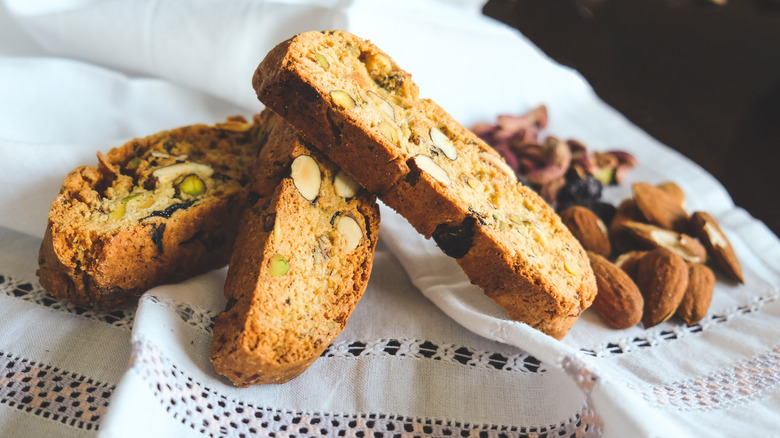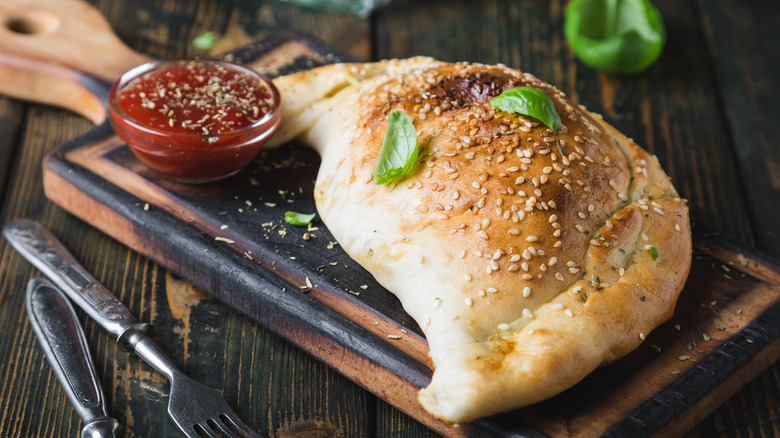You're Pronouncing These Foods Wrong, According To Giada De Laurentiis
While teaching us how to make delectable, restaurant-quality Italian meals at home — such as creamy Carbonara Cacio e Pepe and Chocolate Almond Mousse Cannolis (via Food Network) — celebrity chef Giada De Laurentiis continues to be a reliable source of Italian-based culinary knowledge. She is equally as generous when it comes to sharing her Italian culture with others. "I would say that when people want to know how to say a word properly in Italian, then I'm your person," De Laurentiis stated in an interview with Food Network, in which she lists a series of words in her "Italian Glossary" that non-native speakers often have trouble pronouncing. To help out, Giada De Laurentiis broke down the correct pronunciation for eight popular food terms.
De Laurentiis started off with the soft, sweet cows-milk product reminiscent of cream cheese: "mascarpone." It's pronounced "mahs/kahr/POH/neh" (via How Do You Say That Word) and can be used to enhance sweet and savory dishes alike, according to Giada. A common way of mispronouncing mascarpone is by failing to pronounce the 'e' at the end.
Next, Giada turned to dessert. Directly translating to "pull me up," tiramisu is made from espresso, soft cookies, and sweet cream is typically enjoyed after a hearty meal. The proper pronunciation of the word is "tee/rah/mee/SOOH" (via How Do You Say That Word).
What al dente really means, according to Giada
Italian for "cookies," biscotti directly translates to "twice" (bis) and "cooked" (cotti), and often refers to the dry, crumbly cookies that are sliced into shape for one round of baking, then finished off with a second stay in the oven at a low temperature to fully dry out any moisture. The phonetic pronunciation of the word "biscotti" is "bee/SKOHT/tee," and it is the plural variation of the singular "biscotto" (via How Do You Say That Word).
According to Giada De Laurentiis, the term antipasto is typically used in reference to a "whole table of appetizers" ranging from meats and cheeses to "anything that's marinated." The proper pronunciation of antipasto is "ahn/tee/PAH/stoh" and is the singular version of the plural "antipasti" (via How Do You Say That Word). Some mistakenly believe that "antipasto" means "before the pasta," but that is not the case. In Italian, the word "pasto" directly translates to "meal," not "pasta," so antipasto really means "before the meal."
Another essential Italian word for De Laurentiis? Al dente. Meaning "to the tooth," the term al dente refers to pasta that is not fully cooked all the way through and thus still holds "a little bit of a bite to it," according to Giada (via Food Network). It is described as the "perfect doneness" for pasta because its semi-raw center allows for the noodle to fully soak up whatever sauce it is finished cooking in. According to How Do You Say That Word, the phonetic pronunciation of al dente is: "ahl DEHN/teh."
Why you don't want to mess up "calzone"
Giada De Laurentiis next turned to calzone. Meaning "long sock" or "trousers," this word is pronounced "kahl/TSOH/neh" (via How Do You Say That Word). It is important to note that this word must be pronounced correctly at all times, as omitting the "L" transforms it into an expletive that you definitely wouldn't want to say in a crowded restaurant, or anywhere in public for that matter. The common mispronunciation be taken as offensive or suggestive, so it's best to make sure you get it right the first time.
The word frittata roughly translates to "something fried," but it is typically used in reference to an egg dish that Giada states is "[Italy's] variation of scrambled eggs" (via The Food Network). According to How Do You Say That Word, the phonetic pronunciation of "frittata" is "free/TAH/tah." The dish is similar to an omelet, but instead of being cooked from start to finish on the stovetop, its cooking process is started on a burner and finished in the oven.
Finally, Giada De Laurentiis schools us on risotto. A creamy rice dish that is customizable with whatever ingredients you have on hand, "risotto" is pronounced "ree/ZOHT/toh," and is made by cooking a special type of rice called Arborio in stock until the rice is creamy and tender (via How Do You Say That Word). The seasoned risotto is typically topped with butter and parmesan cheese at the very end of its cooking process.


